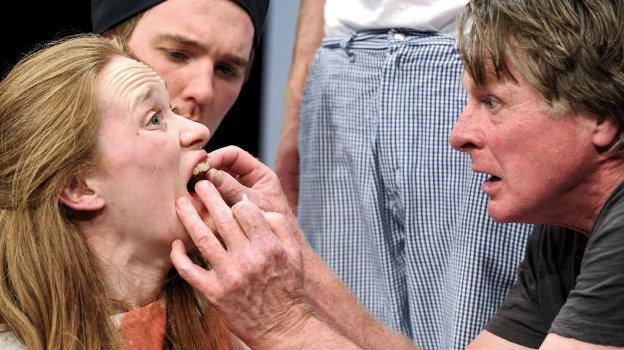‘Take care not to tread on the props,’ says the usher as we enter the space – an empty space save for a row of tawdry everyday objects and accessories placed at the front-row audience members’ feet. There’s a few plastic toys, a pair of spectacles, a walking stick, a wok. Some green Lycra leggings, a sparkly headband, a spanner. Enter five actors – young man, older man, young woman, older woman, man of indeterminate age. They pull down paper from four great rolls of newsprint, so the floor now has a crackly white carpet, and the show is on the road.
We are at The Golden Dragon, a Thai/Chinese/Vietnamese local restaurant anywhere in the world. We meet workers, customers, and occupants of the upstairs flats. Everyone is transient in one way or another: the migrant workers in the kitchen, the air stewardesses just back from a long-haul trip, the couple whose marriage is falling apart, the trafficked sex worker held in an upstairs flat who never sees the light of day. A thousand and one stories interweave – some heartbreaking, some mildly amusing. We are taken on a journey across the world and back again, it all circling round the extraction of a rotten tooth in the mouth of the young Chinese kitchen worker.
What at first seems to be a rather clichéd take on ‘poor theatre’– with characters, for example, denoting old age with the addition of a pair of spectacles and a shaking hand, or waving the wok around to express frying up a Pad Thai – turns into something more interesting as the play progresses: the instant costuming-up becomes more surreal, and the characterisation and storytelling ever more layered – as one example, those green leggings and the hen-party headband with the jangling silver-bobble ‘antennae’ turn the young man into The Cricket, in a little folk tale telling of the industrious Ant and the lazy Cricket, and this character in turn becomes the representation of the ‘vulgar, sexy, abused’ girl upstairs. Meanwhile, the carefully crafted ebbs and flows of the text draw us in, or pull us out, of each storyline.
In his notes in the introduction to the playscript, director Ramin Gray reflects that a British playwright would more than likely have been drawn to naturalism to tackle the subject of migration, but that Schimmelpfennig – a German – draws on his own nation’s Brechtian tradition in the creation of this cleverly multi-layered and ‘playful’ play.
Viewing The Golden Dragon provides an opportune reminder that many of the dramaturgical choices that we associate with devised theatre – the mixing of storytelling mode with dialogue, actors playing many different characters, the transposing of one character’s words to another, actors stepping in and out of the action whilst remaining visible onstage, the voicing of stage directions – can in fact be scripted in, as is the case in The Golden Dragon: the deconstruction of the text occurs within the text.
It’s a clever play, beautifully constructed – a play that has been ‘wrought’ well by the playwright. But more importantly it’s a moving piece of theatre; we travel readily on the journey offered.


